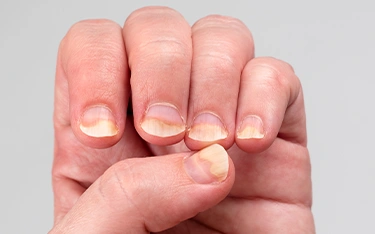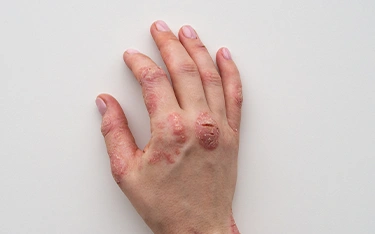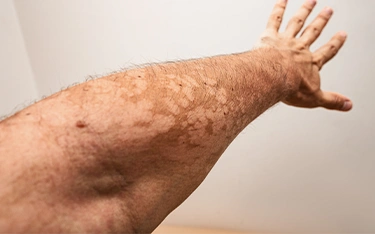Smooth, shiny, pink nails declare good health and are a dream to many. If your nails are pitted, cracked, or discolored, it’s time to see the doctor. This may cause an alarm to look for signs of nail psoriasis.
Nail psoriasis is a chronic condition where psoriasis affects the fingernails and toenails, leading to changes in appearance, texture, and strength. It may present as pitting, discoloration, thickening, or detachment of the nail from the nail bed.
Nail psoriasis is aptly known as psoriatic nail dystrophy. This condition involves the nail matrix or nail bed, resulting in specific or nonspecific clinical changes in the nail. This means the nail psoriasis is the psoriasis underneath the nails.
Nail psoriasis can occur independently and is often seen alongside skin psoriasis or psoriatic arthritis. Psoriasis may occasionally be present with nail involvement alone in approximately 5 to 10% of patients with psoriasis.
Understanding nail psoriasis, nail psoriasis treatment, psoriatic arthritis nails treatment, signs of psoriatic arthritis in nails is crucial because nail involvement may be an early indicator of psoriatic arthritis, a form of inflammatory arthritis that can cause joint pain, swelling, and long-term damage if left untreated.
Severe psoriatic nail disease can lead to functional and social impairments if left untreated. Psoriatic nail disease is not associated with mortality. Identifying nail changes early, seeking proper care, and managing symptoms through medical and lifestyle approaches can significantly improve nail health and overall quality of life.
What is Nail Psoriasis?
The pathogenesis of the psoriatic nail disorder is not completely known. Nail psoriasis may be due to a combined effect of genetic, environmental, and immune factors.
Nail psoriasis is an autoimmune disorder that targets the nails by affecting two key structures: the nail matrix and the nail bed.
- The nail matrix is the tissue beneath the base of the nail that produces new nail cells. When inflamed, it causes nail pitting, ridging, or irregular growth.
- The nail bed lies beneath the nail plate and anchors it to the finger or toe. Psoriasis in the nail bed can lead to discoloration, detachment, or the buildup of skin debris.
Importantly, nail psoriasis may occur with or without visible skin plaques. Research shows that up to 50% of people with psoriasis and over 80% of those with psoriatic arthritis will develop nail changes at some point.
Around 50% of the patients with nail psoriasis had interphalangeal stiffness, pain, and swelling. This makes nail psoriasis a valuable diagnostic marker for clinicians when assessing patients for systemic involvement. Males and females are affected equally by nail psoriasis, and the prevalence of nail psoriasis increases with the age of the population studied.
Include set of images as shown here
Read more: How to stop Psoriasis from Spreading?
Early Signs and Symptoms of Nail Psoriasis
Recognizing the early signs of nail psoriasis can help patients seek timely treatment. Symptoms vary depending on whether the nail matrix, nail bed, or both are affected.
Symptoms of Nail Psoriasis:
- Discoloration: Nails may develop yellow-brown patches, sometimes called “oil drop” or “salmon patches.”
- Pitting: Pitting is nothing but small depressions on the surface of the nail caused by the loss of parakeratotic cells from the surface of the nail plate.
- Crumbling or Brittle Nails: Weakened nails may chip, split, or break easily.
- Onycholysis (Lifting of the Nail): Onycholysis is a white area of the nail plate due to a functional separation of the nail plate from its underlying attachment to the nail bed.
- Psoriasis Under Nail: Skin debris may accumulate beneath the nail, leading to thickening and discomfort.
- Oil-drop discoloration: Pink macule or patch (usually appearing on the proximal nail) or red, discolored spots on the lunula
- Leukonychia: Splinter hemorrhage/dilated tortuous capillaries in the dermal papillae. Splinter hemorrhages are longitudinal black lines due to minute foci of capillary hemorrhage between the nail bed and the nail plate.
These lines are transverse lines in the nails due to intermittent inflammation, causing growth arrest lines.
These changes may affect one or multiple nails, and the severity ranges from mild cosmetic alterations to painful deformities that interfere with daily activities. Since nail psoriasis shares features with fungal infections, professional diagnosis is essential. A nail biopsy is needed to confirm the diagnosis of nail psoriasis in some cases and is usually taken from the nail bed.
Because nail psoriasis can be associated with cutaneous and systemic findings (eg, psoriatic arthritis), a thorough history and physical examination should be performed in patients with nail psoriasis.
Nail psoriasis gets triggered by the same factors as other types of psoriasis, such as,
- Stress: When the body is under stress, it produces higher levels of cortisol and other stress hormones. These chemicals disturb immune system balance, increasing inflammation and prompting the immune system to attack healthy skin and nail cells.
- Use of certain medicines: Certain drugs such as beta blockers, antimalarial drugs, and Interferons used in the treatment of cancer or serious viral infection, may trigger the condition.
- Smoking: Tobacco use weakens the immune system and increases inflammation, which can aggravate psoriasis symptoms and slow down healing of the nails.
- Alcohol: Excessive alcohol consumption can interfere with immune regulation and make treatments less effective, leading to frequent flare-ups.
- Injury or trauma to the skin: Even minor cuts, nail-biting, or pressure on the nails may trigger psoriasis due to the Koebner phenomenon (psoriasis appearing at the site of injury).
- Illnesses such as infections: Viral or bacterial infections can put stress on the immune system, often acting as a trigger for new or worsening psoriasis symptoms.
- Changes in diet: Nutrient deficiencies, unhealthy eating habits, or diets high in processed foods may increase inflammation and make nail psoriasis harder to manage.
When considering nail psoriasis treatment, the approach depends on severity, the number of nails involved, and whether psoriatic arthritis is present. Because nails grow slowly, results often take months to become visible.
One may keep in mind that nail psoriasis isn’t contagious, and treatments can help your symptoms improve. It’s important to be vigilant about the appearance of your nails. Coping with nail psoriasis can be frustrating and depressing, as there is no cure as such to this disorder. The treatments focus on the improvement of the functional and psychosocial aspects of psoriatic nail disease.
At Dr Batra’s Clinic, a personalized treatment is given by the experts in the field. The following treatments help the patient to keep the condition in control.
Also Read:
Psoriasis Causes & Treatment: Frequently Asked Questions (FAQ)
What is Psoriasis and Treatment for Psoriasis-Psoriatic Arthritis
Guttate Psoriasis: Symptoms, Triggers, and the Best Ways to Treat It
Inverse Psoriasis: Causes, Symptoms & Lifestyle Tips
Treatment Options for Nail Psoriasis
A variety of treatment strategies can benefit patients suffering from nail psoriasis. At Dr Batra’s®, we focus on Homeopathy treatments. We address all aspects of a person's illness, including all causative factors - all while not providing harmful medications. There are many approaches to therapy.
- Topical Treatments
Creams, lotions and ointments are the most common and decrease the inflammation while promoting nail improvement. Topicals are typically applied directly to the affected nails and address issues such as pitting and discoloration.
- Systemic Therapies
Patients suffering from moderate to severe cases may be recommended for systemic therapies. Systemic treatments may better result in inflammation and improvement of the skin and nail health since systemic therapy takes place body-wide. At Dr Batra’s® we offer homeopathy as a non-invasive and holistic approach that acts on root causes of the disease.
- Phototherapy
Phototherapy, which includes UV light therapy, slows the rate of abnormal skin cell turnover and may also improve the state of the nails. In some cases, laser therapy may be performed to reduce inflammation and target blood vessels that lie beneath the nail.
- Biological Therapies
Biologics are modern, effective therapies that specifically target the immune system to work to reduce inflammation and prevent damage to the surrounding body systems. Although they are effective therapies for many people, Dr Batra's® Homeopathy offers a safer, natural treatment option that works to restore balance within our bodies.




